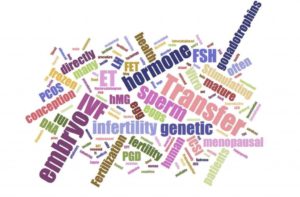What does it all mean?
Sometimes infertility jargon can be confusing! What is the difference between an IUI and an IVF procedure? What are all the hormones produced by the pituitary gland that are impacting your ability to become pregnant?
Here at the Fertility Institute of Hawaii (FIH) we welcome an opportunity to answer any of our patients’ questions and give full explanations of terminology that we use everyday!
ART (Assisted Reproductive Technology) – When eggs are retrieved and mixed with sperm outside of the body for procedures such as IVF (In Vitro Fertilization).
DNA – Deoyribonucleic acid (DNA) is located on our chromosomes and is the genetic/ hereditary material in people (and other living organisms).
ET (Embryo Transfer) – is the last stage of the IVF process where the fertilized embryo is placed within the uterus.
FET (Frozen Embryo Transfer) – An ART cycle in which cryopreserved embryos are thawed and placed into the uterus (ET) after preparing the uterus with estrogen and progesterone. The pregnancy rates for a fresh ET or a FET are similar.
FSH (Follicle-Stimulating–Hormone) – This is a hormone made by a woman’s pituitary gland that acts on the ovary to stimulate follicular development. The oocyte (egg) is located within the follicle. Therefore, FSH will improve the number of eggs that are produced in an IVF cycle. Conception can be impacted if the woman’s FSH level is too high.
ICSI (Intracytoplasmic Sperm Injection) – This is where sperm is directly injected in to the egg. This procedure is often used when there is “male factor” infertility. ICSI can only be performed during an IVF cycle.
hCG (Human Chorionic Gonadotrophin) – a hormone produced by the placental cells once an embryo implants into the uterine wall. This is the hormone that is tested to confirm an early pregnancy –The Pregnancy Test.
hMG (Human Menopausal Gonadotrophins) – A fertility drug that is injected with FSH and LH in equal parts.
HSG – A Hysterosalpinogram (HSG) is a procedure that evaluates the patency of the fallopian tubes to ensure that the sperm and egg can meet during natural conception. If the fallopian tube is blocked, IVF is generally the only option for fertility.
IUI (Intrauterine insemination) – Also referred to as Artificial Insemination. An infertility treatment protocol where the sperm is directly put in to the uterus to help maximize chances of conception. This is not to be confused with IVF where a woman’s eggs are removed and fertilized prior to placing embryos into the woman’s uterus.
IVF (In Vitro Fertilization) – This is the assistive reproduction procedure where a woman’s egg or eggs are removed. The eggs are then joined with the sperm to create an embryo outside of the body in the IVF laboratory. Once fertilization has taken place, the embryo is placed into a woman’s uterus (ET).
LH (Luteinizing Hormone) – Another important hormone used in reproduction which is producd in the pituitary gland, as well. The surge of LH release causes ovulation during the menstrual cycle.
PCOS (Polycystic Ovary Syndrome) – A medical disorder that often is associated with many follicles within the ovaries, hormonal abnormalities, and irregular menses causing fertility problems.
PGD (Preimplantation Genetic Diagnosis) – PGD is a way to look at the chromosomal makeup of the embryos prior to the ET. Many times our patients who are of mature age, have family genetic health risk factors (such as Tay-Sachs) or who wish to minimize health risks to their child, will opt for PGD. This advanced technology is not available in many countries, which is why international patients often seek our services. Read more here
TI (Timed Intercourse) – This is planned intercourse during a peak ovulation time period.
TSH (Thyroid Stimulating Hormone ) – Another hormone produced by the pituitary gland that gives a signal as to when thyroid hormones are made and released in to the body.
To learn more about our center and aspects of infertility – please go to our YouTube page where we have several videos to answer your questions!
